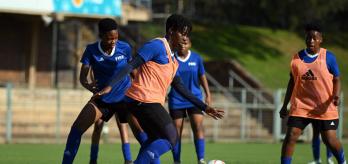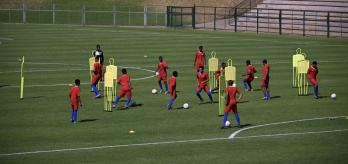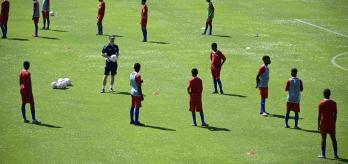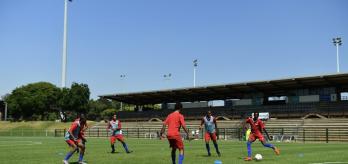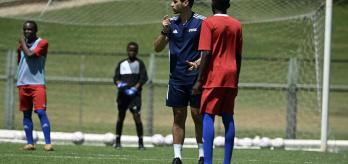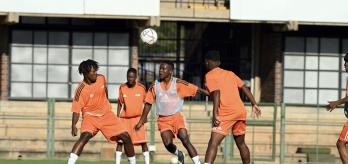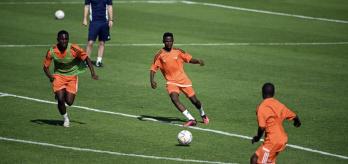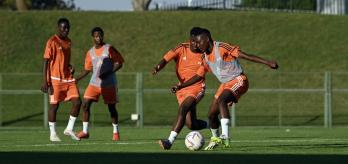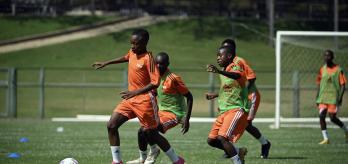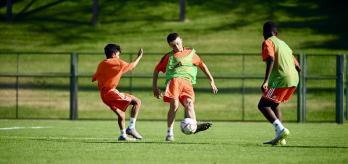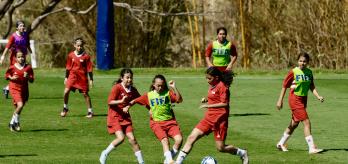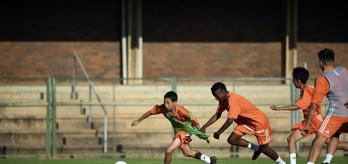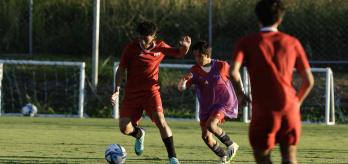Methodology
The intention: What is practised?
From an attacking perspective, the objective of the exercise is to enhance a unit’s ability to build and progress play, while from a defensive viewpoint, the focus is on blocking and preventing, all within a narrow focus. The drill specifically focuses on unit-level elements, such as combining vertically through the thirds, making coordinated on- and off-the-ball movements and running diagonally with the ball towards opponents to free up space for team-mates. The key defensive actions at unit level include reorganising the defensive shape, dropping in to create a compact block and coordinating the press to ensure that players do not leave gaps when faced with a numerical disadvantage. The exercise simulates a scenario involving playing through a high press and into the middle third, where numerical advantages develop to enable a unit to advance into the final third. The skills developed are applicable to various game scenarios, including when the attacking team come up against a high or mid-block.
The scale: For whom is this relevant?
The exercise revolves around the unit and focuses on off-the-ball movement in coordination with the ball carrier’s decision-making. The drill allows a unit to work on skills in a scenario in which it has a numerical advantage when advancing towards the final third. The build-up through the press is particularly relevant to non-ball-carrying players who operate beyond the opposition’s first line of press, such as pivot players, attacking midfielders and centre-forwards. However, the narrowness of the exercise area means that the drill is not particularly relevant to wide players. In addition to unit-level skills, quickly spotting and finding runners, disguised passes and making aggressive, diagonal off-the-ball runs are important individual skills worked on in the exercise. Defending-team players are tasked with deciding when to press or drop to maintain a compact block in front of goal. Further up the pitch, the two front players are asked to press aggressively and prevent passes from being played into the middle third.
The practice type: How is the practice designed?
The drill involves an opposed, small-sided game, featuring variable repetition that provides ample opportunities for a unit to practise quick vertical passes to progress play, aggressive off-the-ball movement, such as making diagonal runs in behind, and quick combination play with a numerical advantage. Variations develop to showcase different options when drawing in defenders to free up space and create opportunities for team-mates in situations of numerical advantage. The fact that the exercise is opposed means that the attacking team are required to display quick decision-making to break forwards in attack and finish on goal. While the exercise is position-specific, with defenders and attackers asked to perform tasks in the relevant areas of the pitch, players in the final two zones can rotate roles.
Session plan
Organisation
-
Use half of a full-size pitch. Position a full-size goal at each end of the exercise area. Place a goalkeeper in each goal.
-
Reduce the width of the exercise area to 25m.
-
Divide the exercise area into 3 zones: build-up zone, middle zone and end zone.
-
Place 3 orange players and 2 blue players in the build-up zone.
-
Place 3 orange players and 2 blue players in the middle zone.
Explanation
-
The exercise starts with the attacking team’s goalkeeper playing the ball to an orange defender in the build-up zone.
-
The 3 orange players in the build-up zone look to keep possession between themselves and progress the ball to their attacking team-mates in the middle zone, while the 2 blue players press them.
-
Once an orange defender plays the ball out of the build-up zone and into one of the orange attackers in the middle zone, two of the orange defenders can progress into the middle zone, creating a 5v2 scenario as the oranges look to attack the blues’ goal.
-
As soon as one of the orange attackers receives the ball in the middle zone, a blue player can drop back from the build-up zone into the middle zone to create a 5v3 scenario.
-
Each time an attacking move ends (i.e. when a goal is scored or the ball goes out of play), play restarts with the attacking team’s goalkeeper.
-
If the blues win the ball, they can attack the oranges’ goal without any zonal restrictions.
Key coaching points
Roles of coaches
-
First coach: leads the exercise by establishing the objectives and underlining the key aspects when building up play with a numerical advantage.
-
Second coach: frequently intervenes and offers the players strategies to be more effective in the final third.
-
Third coach: encourages the defending team.


























